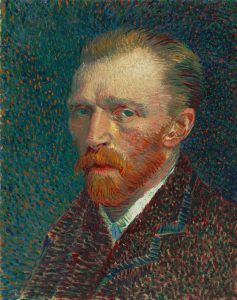
"I just want to be one of them" says Willem Dafoe/Vincent Van Gough. "I would like to sit down with them, and have a drink, and talk about anything. I’d like them to give me some tobacco, a glass of wine, or even just ask me “How are you today?” These short monologues are interjected through the film as voiceover on a black screen. All you’re given to focus on is Dafoe’s voice, and there’s something incredibly beautiful and calming about that – especially because of the severity of the events that follow. These are the troubled last years in Vincent van Gough's life in Arles, France – and the beauty that came out of them. Whilst there’s still some mystery about how they played out (and especially how they ended) the film forms its own opinion – van Gough is shot in the film – but some facts stay the same; 30 hours later he was pronounced dead.

It's not a perfect film - some dialogue seems too straight-forward in its subject matter, with metaphors being more visual - meaning it can sometimes come off as a bit forced; here's a conversation about morality, here's a conversation about legacy, etc. But what the film lacks in drama or clear-cut conversations, it makes up for by being bloody beautiful to watch. Long shots of landscapes, trees, Gough at work are all undercut by Tatiana Lisovskaya’s subtle yet solemn piano-based score. And when the film decides to have a conversation, the forth wall becomes almost non-existent and Gough, Gauguin (Oscar Isaac) and other characters look into the camera to talk to you. It’s intimate, and at times a little disconcerting, given the lack of dialogue throughout the whole film. Combined with more shaky handheld camera action from particular points of view, and it’s almost enough to make you feel like you’re in the fields of Arles and not stuck inside.
Dafoe’s portrayal of the famous painter is incredible – enough to have him nominated for best actor at the Oscars in fact. And rightly so; At Eternity’s Gate recognises both Van Gough’s vulnerability, and the seriousness of what his breakdowns led him to do. He thrives on his own, even in scenes without dialogue or soundtrack where all the pressure is on his performance. It’s ultimately a film about the desire to be remembered – opening Eternity’s Gate if you will – and Dafoe’s performance is another piece in the jigsaw of ensuring the artist lives on; both the good and the not so good parts of his life.
It might not be the obvious choice in times like these, but at the very least it’ll remind you to go outside more often after all this. And if you do wind up watching it, I’ll give you bonus points for doing a double-bill with Loving Vincent. Deal?

At Eternity's Gate is available on Netflix now (keep watching until after the title credits for another small scene!)